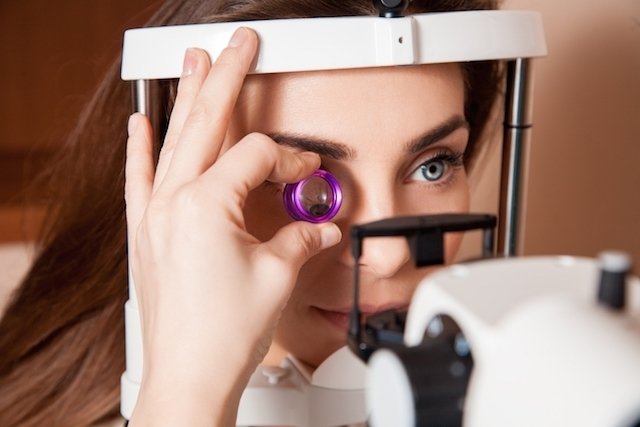Diabetic retinopathy is a complication of diabetes that affects the eyes, causing an increase in the permeability of blood vessels in the eyes and interfering with vision.
Initially, diabetic retinopathy does not cause signs or symptoms and can be discovered during routine exams. However, if blood sugar remains uncontrolled for a long time, symptoms such as gradual worsening of vision, blurred vision, dark spots in the vision, partial loss of vision or irreversible blindness may appear.
The treatment of diabetic retinopathy is carried out by an ophthalmologist and an endocrinologist together, as it involves adequate control of blood sugar levels with diet, physical exercise and antidiabetic medications. Furthermore, if complications arise from diabetic retinopathy, such as macular edema, the ophthalmologist can recommend medicines to be applied inside the eyes. See how diabetes is treated.

Symptoms of diabetic retinopathy
The main symptoms of diabetic retinopathy are:
- Difficulty reading or seeing distant objects;
- Small black dots or lines in the vision;
- Blurry vision;
- Dark spots in the vision, called “floaters”;
- Difficulty seeing;
- Difficulty identifying different colors.
However, these symptoms are not always easy to identify before blindness appears and, therefore, it is very important that people who suffer from diabetes keep their sugar levels well controlled and make regular appointments with the ophthalmologist to assess their eye health. Find out what to do to control diabetes.
Make an appointment with your nearest ophthalmologist to evaluate the possibility of retinopathy:
Taking care of your health has never been easier!
How the diagnosis is made
Diabetic retinopathy is diagnosed by an ophthalmologist through an eye exam, in addition to a detailed assessment of your health history, how long you have had diabetes, as well as the antidiabetic medications you use, and the results of blood glucose tests. Check out the main tests for diabetes.
Furthermore, in some cases the doctor may also recommend fluorescein angiography, which is a test that allows the doctor to identify images of the blood vessels that are present in the retina.
Possible causes
Diabetic retinopathy is caused by uncontrolled diabetes for a long time. This is because high blood sugar levels can block the small blood vessels that reach the retina, causing fluid loss or bleeding.
To compensate for blocked blood vessels, the eyes develop new blood vessels that don’t work properly. However, these new blood vessels can leak or bleed easily, leading to symptoms.
Types of retinopathy
Diabetic retinopathy can be divided into 2 different types:
- Non-proliferative diabetic retinopathy: which corresponds to the initial stage of the disease, in which the presence of small lesions in the blood vessels of the eye can be seen;
- Proliferative diabetic retinopathy: It is the most serious type in which there is permanent damage to the blood vessels in the eyes and the formation of more fragile vessels, which can rupture, worsening vision or causing blindness.
To avoid diabetic retinopathy, it is important that diabetes treatment is carried out in accordance with the endocrinologist’s recommendations, and it is also important to have a healthy diet and practice physical activity regularly, in addition to monitoring glucose levels throughout the day. See more about the complications of diabetes.
How the treatment is carried out
The treatment of diabetic retinopathy must be guided by an ophthalmologist and may vary according to the severity and type of retinopathy.
The main treatments for diabetic retinopathy are:
1. Medical follow-up
In the case of non-proliferative diabetic retinopathy, the doctor may choose to simply monitor the evolution of the situation without carrying out any specific treatment.
Therefore, follow-up with the ophthalmologist must be carried out:
- Once a year, in cases of very mild non-proliferative diabetic retinopathy;
- every 6 to 12 months, in cases of mild to moderate non-proliferative diabetic retinopathy;
- every 2 to 4 months, severe to very severe non-proliferative diabetic retinopathy.
Furthermore, the doctor must ensure that diabetes treatment is being carried out appropriately, with monitoring by an endocrinologist, and that antidiabetic medications are being used correctly, in addition to checking the results of tests that measure blood levels. blood sugar, in order to prevent the progression of diabetic retinopathy.
2. Use of medications
The use of medications may be recommended by the ophthalmologist in cases of complications of proliferative diabetic retinopathy, such as macular edema.
In these cases, the main medications are vascular endothelial growth inhibitors (VGFR), such as:
- Bevacizumab;
- Ranibizumab;
- Aflibercept;
- Brolucizumabe;
- Faricimab.
These medications are applied by an ophthalmologist inside the eye, using local anesthesia, and can help delay or reverse diabetic retinopathy and improve vision.
This is because these medications work by blocking a protein known as vascular endothelial growth factor, which is responsible for leaking blood vessels, causing inflammation in the retina and abnormal growth of blood vessels, damaging the eye.
3. Laser surgery
Laser surgery, called laser photocoagulation, is indicated in more advanced cases of proliferative diabetic retinopathy as it eliminates the blood vessels that are forming in the eyes and that are causing vision problems, allowing bleeding to stop, if present.
4. Corticosteroid implant
A long-acting corticosteroid implant, such as dexamethasone, applied by an ophthalmologist inside the eye, helps reduce inflammation and swelling due to macular edema caused by proliferative diabetic retinopathy.
Generally, this type of treatment is indicated when there is no improvement with the use of vascular endothelial growth inhibitors (VGFR), as they control inflammation in the long term, but can have the side effect of increasing intraocular pressure and the development of glaucoma.
5. Vitrectomia
In cases where there is constant bleeding and there are many scars in the eyes, the doctor may recommend surgery called vitrectomy, in which the turbo vitreous is replaced and the sources of bleeding in the retina are repaired.
Read too: Vitrectomy: what it is, when it is indicated, types and how it is done
However, the person must always maintain adequate diabetes treatment to prevent retinopathy from worsening, even in cases of non-proliferative diabetic retinopathy, and avoid the emergence of other complications, such as diabetic foot and heart changes.
How to prevent diabetic retinopathy
Diabetic retinopathy can be prevented with adequate control of diabetes, a balanced diet, regular physical activity and the use of hypoglycemic medications used correctly to control blood sugar levels. Check out what a diabetes diet should be like.
Furthermore, people with diabetes should have consultations at least once a year with an ophthalmologist, so that it is detected and treated early, to avoid complications such as macular edema, which can lead to partial loss of vision or irreversible blindness, which is generally in both eyes.

Sign up for our newsletter and stay up to date with exclusive news
that can transform your routine!
Warning: Undefined array key "title" in /home/storelat/public_html/wp-content/plugins/link-whisper-premium/templates/frontend/related-posts.php on line 12
Warning: Undefined array key "title_tag" in /home/storelat/public_html/wp-content/plugins/link-whisper-premium/templates/frontend/related-posts.php on line 13



